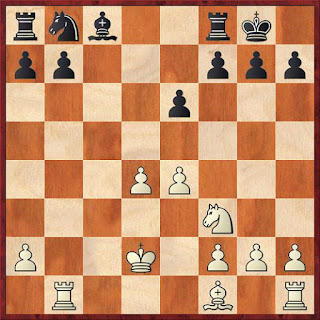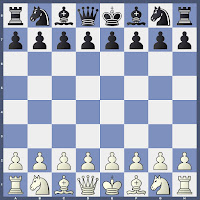Simple moves are profound! - a game from IOM
"Some people have one great dream in life which they fail to fulfil. Others have no dream at all and fail to fulfil even that...." - Fernando Pessoa
.....simple moves are the most difficult to visualise, understand and.....play!
Surgeon Atul Gawande writes thus, in his famous book "Complications": "We look for medicine to be an orderly field of knowledge and procedure. But it is not. It is an imperfect science, an enterprise of constantly changing knowledge, uncertain information, fallible individuals, and at the same time lives on the line. There is science in what we do, yes, but also habit, intuition, and sometimes plain old guessing. The gap between what we know and what we aim for persists. And this gap complicates everything we do."
.....and what can we say of Chess....and the assumptions that we carry about the act of playing....knowledge in chess.....understanding in chess......
Everything that Gawande said above applies to chess too....only difference is that here the lives or not on the line....but individual pursuits....victory and its shadow defeat....I assume draw to be half loss!
If a doctor or the patient fear about the possibility of death...then doc will be doing injustice to his profession and the patient....to his existence!
Likewise, a chess player can never hope to eliminate the third result (through 'meticulous' training and error eradication through engines) and attain mastery and emerge victorious.....as he would be killing the seeds of victory and not tapping on the potential of his opponent to go wrong too....!
So, all that a player can do is to "SimplyPlayChess" and not worry about anything else....!
Yes, Simple moves are the most difficult to conceive....and play....but that is the only way forward!
Take for eg., this famous position.....
Rubinstein - Schlechter San Sebastian, 1912
13.Bb5!!
Rubinstein had a great vision to put that Bishop on void.....
A Tom, Dick or Harry can play this move and Rubinstein can play this move.....but the difference will be in the "why" and "what-next"!
13......a6
and even the great Schlechter could not resist poking that Bishop....and oblige Rubinstein! Ideally Black would want to keep the pawn structure intact....but both White Rook on b1 and the Bishop which has appeared on b5 are generating heat!
Rubinstein went on to win in great fashion....by increasing his pressure on Black's weakened pawn structure with a Rook on seventh rank and a very active Knight and Bishop. Schlechter was merely responding to Rubinstein's barrage of simple threats!
Rubinstein and Capablanca of that period and Karpov in modern era, played innumerable games in such simple and economic fashion!
It reminds me of an anecdote which Ivan Sokolov quoted in his wonderful book "Ivan's Chess Journey".
Sokolov and Ulf Andersson were working for Timman during his match with Kasparov in 1998. In one of the theoretical discussions, they reached the following position which arises out of Nimzo Indian.
And here, Ulf Andersson asked Sokolov, "...so, what's your problem here"? To which Sokolov responded, "Well, Ulf, White will recover his pawn and your c5 is weak, the White King is on the side where he has to be and you will suffer and likely lose!"
And Andersson thought for 15 minutes and replied, "No, your e3 is also weak, my c5 is difficult to take, I have counter play. I will never lose this!"
And Timman easily drew that position and Sokolov wrote, "Ulf came to the conclusion that Black could hold this out and it took him just 15 minutes to figure out something which Kasparov's team and many others could not understand in hours!"
So, Ulf Andersson joins the list above....and perhaps there would be many others too!
My point is that, Chess understanding is something which grows with a person over a period of time....and one's chess culture and thoughts...not to forget the most important aspect, working individually and generating fresh ideas and thought process....keep asking questions to oneself, however silly it may look, and finding an answer to those questions by self exploration and allowing one to arrive at such critical judgments.....decisions....and this is what we commonly call as "understanding"!
It can never be taught!
Yesterday in IOM, Shirov played a similar game against Vidit.
Alexie Shirov - Vidit Santhosh Gujrathi, IOM, 2016
We are in opening stage - not a great revelation though....but what I essentially wish to state here is, that, the most important stage - the transition between opening and middle-game - is yet to arrive!
Transition phase is the most important phase in life and in chess! Because.....
.....the borderline is almost always thin...blur....undefined in transitions! And here, nothing, will come to one's aid....except....his true understanding of the situation!
11.....Qd7
A simple move so as to allow the Knight to recapture on d5.
And can't the "c" pawn do that job? After all it is fragment and by cd5 it can rejoin with his pal and metamorphoses into a protected passer!?
The answer is NO! The answers could be murky.....but has a grain of truth and justification in it! First of all, on reaching d5, that pawn would be immobile with the White Knight standing rock solid on d4-square! Secondly, it reduces the scope of the Knight which can exert pressure on White position sitting on d5.
Moreover, cd4 would leave White with a simple pawn majority on the Queens wing with all his pieces trained to guard the squares in front for an invasion.
12.cd5
In Gelfand - Karpov, Candidates mt, 1995; the play went, 12.Nc3 dc4 13.Na4 Nd5 14.Nf5 ef5 15.Bd4 Rd8 16.Qf3 c5!
A fine simplification manoeuvre!
17.Nc5 Qb5 18.a4 Qb4 19.e6! Bc5 20.Bg7 Rg8 21.ef7 Kf7 22.Bc3 Nc3 23.Qf5 Kg7 and the game ended in perpetual checks!
I found another fine game in this line between Khalifman and Laznicka!
Khalifman - Laznicka, Plovdiv, 2012
12.Qa4 Qd7 13.Na3 c3 14.bc3 Nd5 15.Nf5 ef5 16.Nc4 Be7 17.Rfd1 OO 18.Nb6 Nb6 19.Bb6 Qe6 20.Bc7 f6 21.Qb3! Kf7 22.Bd6 fe5 23.Be5 Qb3 24.a3 Rfd8 25.Kf1 g5 26.f4 gf4 27.Bf4 Rd1 28.Rd1 Ra7
And in this position, which incidentally is in equilibrium, Khalifman found a nice route for his Rook so as to probe Black's pawn islands! Such endings are very deceptive under its simple facade.
29.Ra1 Bf6 30.Ra5! Bc3 31.Rf5 Ke8 32.Ke3 Rf7 33.Rf7
.....and White won the ending with the support of Black...ofcourse!
Coming back to Shirov - Vidit....
12......Nd5 13.Nf5 ef5 14.Bd4 Rb8 15.Nc3! Nc7 16.Ne2 Ne6 17.Bc3 c5 18.Ng3 g6 19.Qf3!
A simple move,....but the beginning of what would eventually bring down Black! However......
.....the position, as with the millions of other games which are lost are won....is in equilibrium. This term "equilibrium" is ubiquitous and is a nebulous word like "relativity" in Science....and is as "complicated" as the word "simple"!!
19.....Qb7
Without attaching a question mark and and exclamation mark to this move.....let me ask the question....."is this necessary"!? We would not know even now and it will be all the more difficult to know during thick of action on board! Black could prepare for castling by putting his Bishop on g7 without worrying about the hole on d6 and f6....as White Knight is long way from reaching there and moreover, Black too can load heavy pieces on the d-file and if need be put that Knight on d4. The pressure on the c5 pawn is compensated with the activity of pieces and pressure on White's e5 pawn.....and if White decides to reinforce it with a subsequent f4, then the e4 square falls in Black's hand!
But, as the number of pieces gets reduced, the pawn islands will begin to look conspicuous!
20.Qb7 Rb7 21.Rfd1 Be7 22.Nf1 Nd4 23.Ne3 f6 24.ef6 Bf6 25.Kf1 Kf7 26.Rac1! Rd8 27.Ba5 Rc8?
Black's last move allowed b4... Should have put thar Rook on b8 instead, avoiding the pin.
28.b4 Be7 29.Nd5 Ne6 30.Ne7 Ke7 31.Rc4 Rd7 32.Rdc1 Rd2 33.a4 Rd4 34.Rd4 Nd4 35.bc5 Ke6 36.Rd1 Nb3 37.Rd6 Kf7 38.Ra6 Rc5 39.Bb6 Rc6 40.Ra7 Ke6 41.Be3 h5
.....and White won in another 20 moves.
Chess is a very simple and resilient game......and paradoxically, it requires effort to lose and effortlessness to win!
End








.jpg)
.jpg)

Comments
Post a Comment